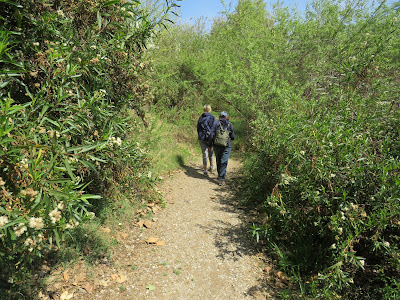With temperatures in the low 60’s, a gentle sea breeze and sunny skies, we climb a paved trail at Deane Dana Friendship Park, a 120-acre, hill-top nature preserve overlooking the city of San Pedro, on the south end of the Palos Verdes Peninsula. Soon, we come upon a field, colored by yellow blossoms of Black Mustard. This tough plant germinates early in winter before native plants have taken hold, shoots up more than 6 feet tall, hogs the sunlight with its thick stalks and lays down a deep system of roots that beats out native plants for water. Coming closer, I hear sounds of West Coast Spring Field Crickets. Glancing down the hill, I notice a large stand of gray mustard stalks from previous years that have dried up and now serve as kindling for a potential wildfire that could occur anytime considering this winter’s severe drought. To make matters worse, these plants lay down thousands of seeds and are one of the first to germinate after a fire. Further up the hill, I notice blossoms of Wild Radish as well as Garland daisy plants, some displaying both yellow and white blossoms. Up ahead, I spot some colorful groundcover consisting of tiny pink blossoms of Stork’s bill and a California Towhee taking a bath. Nearby, I pause to pick a Lavender blossom and enjoy its lovely aroma. Turning around and heading downhill, I see a Rattlepod plant. The name refers to the rounded, inflated seedpod that contains several pea-like seeds. When dry and hard, the seeds rattle around when the pods are shaken. Other common names include Santa Barbara milkvetch and Ocean locoweed. All parts of the plant are toxic if eaten, which explains the common name ‘Locoweed’ as domesticated horses, cows and sheep can become quite ill if they eat too much. Further down the hill, I come upon a noisy Raven and a Ponderosa Pine with its 5-inch needles, textured trunk and colorful, male pollen cones. Even though these cones will soon fill the surrounding air with clouds of powdery pollen gains, they are not a source of inhalant allergies. After viewing a residential area of San Pedro below, I stop to watch a honeybee feeding on a Hairy Rockrose blossom. Just before reaching the car, I look on the ground to see the nickel-size shell of a White Garden Snail. These invasive gastropods can cause severe defoliation of several plants, including vegetables, citrus and ornamentals.
Away from winter
Away from the din
Wetlands await
Nature awakes
Tones of revival set
Peepers and redwings declare
Dames and ganders gather
Muskrats and mallards move
Herons and cattails stand still
Duckweeds line the shore
With lively shades of green
Spring finds the marsh and me
D. DeGraaf



